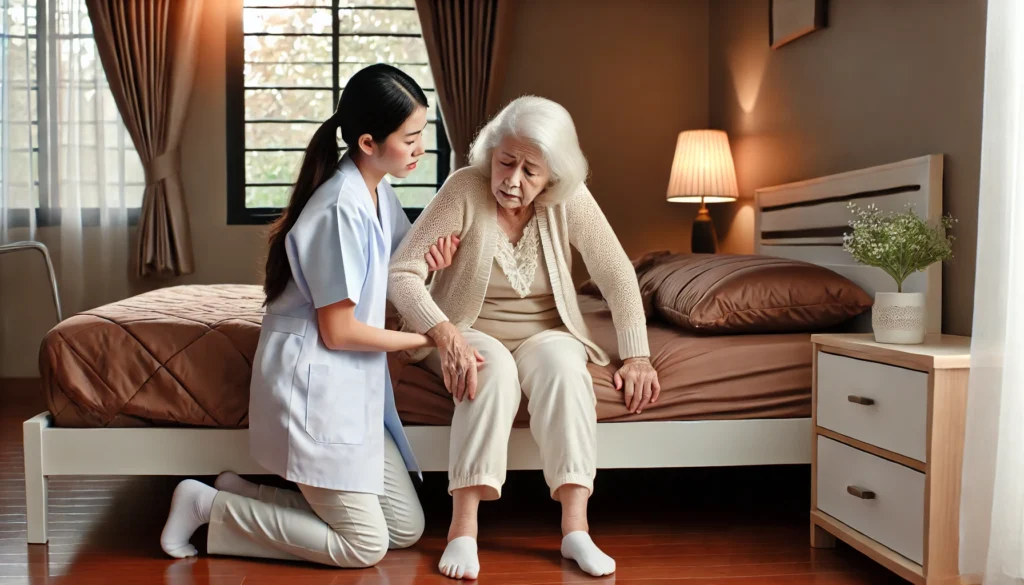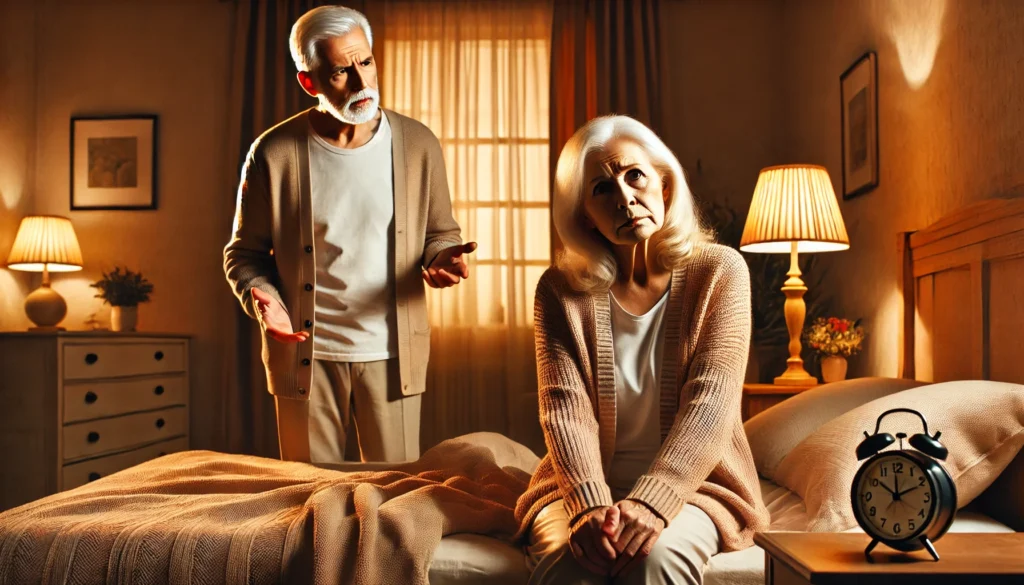Falling out of bed is not uncommon among older adults, but it may signal more than just a simple accident. It can be an early indicator of cognitive decline and a symptom of dementia. Dementia is a complex neurodegenerative condition characterized by a decline in memory, thinking, and social abilities. It is crucial to recognize that while not every bed fall is indicative of dementia, frequent falls can raise concerns about underlying cognitive issues.
You may also like: Tips to Improve Low Average Memory Performance
Is Falling a Sign of Dementia?
The question, “Is falling a sign of dementia?” is one that many caregivers and health professionals encounter. While falling itself is not a definitive sign of dementia, it can be a red flag when accompanied by other symptoms. Dementia affects the brain’s ability to process information, which can lead to disorientation, impaired judgment, and decreased spatial awareness—factors that contribute to an increased risk of falls.
Moreover, the cognitive decline associated with dementia often manifests subtly, making falls an early warning sign that should not be ignored. Caregivers should observe for patterns in falls and whether they occur alongside other behavioral changes. In some cases, falling might also reflect changes in gait or balance, which are symptoms to be monitored closely.
Dementia Symptoms to Watch For
When assessing the risk of dementia in individuals who have experienced bed falls, it is important to consider other dementia symptoms. These may include:
- Memory Loss: Forgetfulness that disrupts daily life, such as missing appointments or forgetting familiar names and places. Memory loss in dementia is often progressive and affects recent memories more than older ones, indicating that while a person may remember childhood events, they might forget what they had for breakfast.
- Confusion: Difficulty understanding time, place, or events. This can be particularly evident when an individual struggles to keep track of dates or seasons, or if they feel lost in familiar settings. Such confusion can increase anxiety and fear, leading to actions that heighten fall risk.
- Language Problems: Trouble finding the right words or following conversations. This symptom can lead to frustration and social withdrawal, which may further contribute to cognitive decline. An inability to communicate effectively can also result in misunderstandings about safety instructions, indirectly increasing fall risk.
- Mood Changes: Unexplained shifts in mood or behavior. Individuals may become easily upset, anxious, or depressed, which can affect their motivation and willingness to engage in activities that could help reduce fall risk.
- Difficulty Completing Tasks: Challenges in carrying out routine activities, like cooking or managing finances. This difficulty often reflects a decline in executive function, which is crucial for planning and completing multi-step tasks. As a result, individuals may neglect personal safety measures, inadvertently increasing their risk of falls.
Identifying these symptoms, in conjunction with falls, can provide a more comprehensive view of an individual’s cognitive health.

Understanding the Causes of Bed Falls
Several factors contribute to bed falls in older adults. Understanding these causes can help in determining whether dementia plays a role.
Physical Factors
Physical changes due to aging, such as muscle weakness, impaired vision, and balance issues, can increase the risk of falls. Muscle mass and strength often decrease with age, impacting stability and coordination. Conditions like arthritis or Parkinson’s disease may also contribute to instability, making it more likely for an individual to fall out of bed.
Vision impairment, common in older adults, can make it difficult to navigate spaces safely, particularly at night or in low-light conditions. Balance issues, often exacerbated by medications or chronic conditions, further increase the likelihood of falls.
Environmental Factors
The environment in which an individual sleeps can significantly impact fall risk. Poor lighting, cluttered spaces, and inappropriate bed height can all contribute to accidents. Ensuring a safe sleeping environment is essential in minimizing fall risk.
For example, the presence of loose rugs or cords can create tripping hazards, while inadequate lighting can prevent individuals from seeing these hazards clearly. The height of the bed is also crucial; beds that are too high or too low can make getting in and out challenging, increasing fall risk.
Cognitive Factors
Cognitive impairments associated with dementia can lead to disorientation and confusion, increasing the likelihood of falling out of bed. Individuals with dementia may struggle with recognizing their surroundings or understanding their physical limitations, which can result in accidents.
Disorientation can cause individuals to misinterpret their environment, leading them to make unsafe choices, such as attempting to get out of bed unsupervised. Cognitive decline can also impair the ability to remember safety instructions, further heightening the risk of falls.
Preventing Bed Falls in Dementia Patients
Preventing bed falls in individuals with dementia requires a multifaceted approach. Here are some strategies to consider:
Environmental Modifications
Making the sleeping area safer is paramount. Use nightlights to improve visibility, remove tripping hazards, and consider installing bed rails or using a low bed to reduce the risk of injury from falls.
Bed alarms can also alert caregivers when an individual attempts to get out of bed, allowing for timely assistance. Additionally, ensuring that frequently used items are within easy reach can prevent individuals from overreaching and losing balance.
Physical Activity
Encouraging regular physical activity can improve strength, balance, and coordination, reducing the likelihood of falls. Tailoring exercises to an individual’s abilities and preferences can enhance their effectiveness.
Activities such as walking, tai chi, or water aerobics can be particularly beneficial. These exercises not only improve physical health but also boost confidence, which may reduce anxiety related to movement and decrease fall risk.
Cognitive Support
Engaging individuals in cognitive activities, such as puzzles or memory games, can help maintain mental sharpness and awareness. Providing clear, simple instructions and routines can also reduce confusion and disorientation.
Structured daily routines can offer a sense of stability and predictability, which is comforting for individuals with dementia. Additionally, involving family members in these activities can provide emotional support and strengthen relationships, contributing to overall well-being.
Medication Management
Reviewing and managing medications with healthcare providers can also play a critical role in preventing falls. Many older adults take multiple medications, some of which can cause dizziness or drowsiness. Regular medication reviews can help in adjusting dosages or switching medications to minimize side effects that contribute to falls.
Professional Support
Involving healthcare professionals such as occupational therapists can provide valuable insights into fall prevention. They can assess the home environment, recommend modifications, and provide training on safe movement techniques. Regular check-ups with healthcare providers can also ensure that any new symptoms or changes in condition are promptly addressed.

Future Implications and Research
As our understanding of dementia and its associated risks continues to evolve, ongoing research is essential. Studies focusing on the relationship between bed falls and dementia can provide valuable insights into early detection and prevention strategies. Additionally, advancements in technology, such as wearable devices and smart home systems, offer promising opportunities for monitoring and reducing fall risk in dementia patients.
Technological Innovations
Innovations like wearable technology can track movement patterns and alert caregivers to potential fall risks. Smart home systems can provide real-time monitoring and alerts, ensuring timely interventions when necessary. These technologies can offer peace of mind to caregivers and improve the independence of individuals with dementia.
Importance of Early Detection
Early detection of dementia-related symptoms is crucial in managing the condition effectively. Research into biomarkers and diagnostic tools continues to advance, offering the potential for earlier and more accurate diagnosis. This can lead to timely interventions that may slow progression and improve quality of life.

Collaborative Research Efforts
Collaborative efforts among researchers, healthcare providers, and technology developers can accelerate the development of effective fall prevention strategies. Sharing findings and best practices can enhance the collective understanding of dementia and its
Further Reading:
What to know about dementia posturing
Acting Out Dreams Linked to Development of Dementia, Mayo Clinic Study Finds
Important Note: The information contained in this article is for general informational purposes only, and should not be construed as health or medical advice, nor is it intended to diagnose, prevent, treat, or cure any disease or health condition. Before embarking on any diet, fitness regimen, or program of nutritional supplementation, it is advisable to consult your healthcare professional in order to determine its safety and probable efficacy in terms of your individual state of health.
Regarding Nutritional Supplements Or Other Non-Prescription Health Products: If any nutritional supplements or other non-prescription health products are mentioned in the foregoing article, any claims or statements made about them have not been evaluated by the U.S. Food and Drug Administration, and such nutritional supplements or other health products are not intended to diagnose, treat, cure, or prevent any disease.


